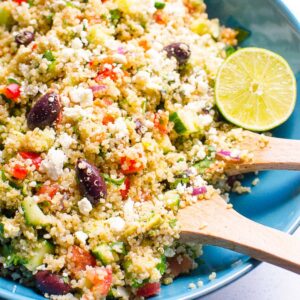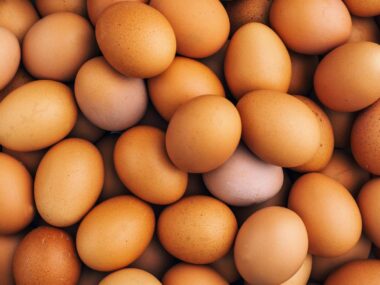Quinoa salad is often seen as a superfood due to its exceptional nutritional profile. It stands out not only for being a source of complex carbohydrates but also as a complete protein with rich nutrients. It provides all nine essential amino acids that the body cannot produce on its own.
Nutritional highlights of quinoa and its role as a nutrient powerhouse:
1. Complete Protein Source: Quinoa salad is a rare plant-based complete protein, making it an excellent option for vegetarians and vegans.
It contains all essential amino acids, including lysine and isoleucine, which are usually limited in plant-based foods.
Protein is essential for muscle growth, repair, immune function, and the production of enzymes and hormones.
2. Dietary Fiber: rich in dietary fiber, which supports digestive health, aids in preventing constipation, and promotes a feeling of fullness.
A high-fiber diet is associated with a reduced risk of various chronic diseases, including heart disease and type 2 diabetes.
3. Essential Micronutrients: Good source of essential vitamins and minerals, including magnesium, iron, phosphorus, and zinc.
Magnesium is important for muscle and nerve function, while iron is crucial for oxygen transport in the blood.
4. B Vitamins: contains B vitamins such as folate (vitamin B9), riboflavin (vitamin B2), and vitamin B6. These vitamins play a role in energy metabolism, brain health, and the formation of red blood cells.
5. Antioxidants: rich in antioxidants, including quercetin and kaempferol. These compounds help neutralize harmful free radicals in the body, reducing oxidative stress and inflammation.
6. Low Glycemic Index: relatively low glycemic index (GI), which means it doesn’t cause rapid spikes in blood sugar levels.
This can be beneficial for managing blood sugar and insulin levels, particularly for individuals with diabetes or those aiming to control their carbohydrate intake.
7. Gluten-Free: It is naturally gluten-free, making it a suitable grain alternative for individuals with celiac disease or gluten sensitivity.
8. Filling and Satiating: The combination of protein and fiber in quinoa helps keep you feeling satisfied and full, which can support weight management by curbing overeating.

Ingredients:
For the Salad:
- 1 cup quinoa, rinsed
- 2 cups water or vegetable broth
- 1 cup cherry tomatoes, halved
- 1 cucumber, diced
- 1 red bell pepper, diced
- 1/2 red onion, finely chopped
- 1/2 cup Kalamata olives, pitted and sliced
- 1/2 cup crumbled feta cheese
- 1/4 cup fresh parsley, chopped
- 1/4 cup fresh mint leaves, chopped
For the Dressing:
- 1/4 cup extra virgin olive oil
- 2 tablespoons lemon juice
- 1 teaspoon dried oregano
- Salt and pepper to taste
Instructions:
- Cook the Quinoa:
- In a medium saucepan, bring the water or vegetable broth to a boil. Add the quinoa and a pinch of salt.
- Reduce the heat to low, cover, and simmer for about 15-20 minutes, or until the quinoa is cooked and the liquid is absorbed. Fluff with a fork and let it cool.
- Prepare the Vegetables:
- Next, In a large bowl, combine the halved cherry tomatoes, diced cucumber, diced red bell pepper, finely chopped red onion, sliced Kalamata olives, crumbled feta cheese, chopped parsley, and chopped mint.
- Make the Dressing:
- In a small bowl, whisk together the extra virgin olive oil, lemon juice, dried oregano, salt, and pepper.
- Combine and Chill:
- Add the cooked and cooled quinoa to the bowl of vegetables. Pour the dressing over the mixture and toss everything together until well combined.
- Serve:
- Finally serve the Mediterranean Quinoa Salad immediately or refrigerate it for a couple of hours to allow the flavors to meld.
However, this salad can be served as a complete meal or as a side dish. It’s versatile, so feel free to customize it by adding other Mediterranean ingredients like roasted red peppers, artichoke hearts, or pine nuts.
In addition, quinoa is generally well-tolerated, some individuals may experience sensitivity to saponins, natural compounds found in quinoa.
Rinsing quinoa thoroughly before cooking can help reduce saponin content and minimize any potential digestive discomfort.
Finally, quinoa’s nutritional richness and versatility make it a valuable addition to a balanced and healthful diet.










